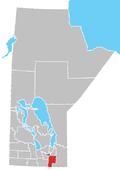St-Pierre-Jolys
Agriculture is the dominant industry: primarily dairy farming and livestock. Being important sectors for the life of the community, the local businesses, services, and hospitality are strong.
Tourism is also important to the village: the former Crow Wing Trail is now part of the Trans-Canada Trail, and St. Pierre-Jolys hosts several popular festivals, such as la Cabane à Sucre (maple syrup festival) in April; le Festival Chantecler, a celebration of Francophone arts; and the signature St-Pierre-Jolys Frog Follies and Ag Fair (les Folies Grenouilles et Foire Agricoles), a village fair featuring the Canadian frog jumping competition.
There are 3 schools, a hospital, and a sizable Royal Canadian Mounted Police detachment in the village.
Bilingual St-Pierre-Jolys has collaborated with the nearby St. Malo on several ventures, including a trade show and a hockey league.
The dramatic sequences for the 2012 documentary We Were Children were shot there.
History
Part of the 19th-century Crow Wing Trail linking Upper Fort Garry with St. Paul (now MN), the area was initially settled by francophone people of Métis and Québécois heritage. English settlers later came as well, in smaller numbers. Father Noel-Joseph Ritchot and Mr. Joseph Dubuc both helped with St. Pierre's founding. The Brittany-born Father Jean-Marie Jolys started a parish and encouraged many Quebec families to move here. The name "Jolys" was added to "St. Pierre" around 1922 to recognize the 40 years of Father Jolys as parish priest of St. Pierre. The Roman Catholic faith has been inextricably linked to the settlement's growth. A former convent of the Sisters of the Holy Names of Jesus and Mary is now the village museum. Though the post office opened in 1879, St. Pierre-Jolys was only incorporated as a village in 1947.
A unique part of the area's history was the establishment of a POW camp that held German soldiers captured during World War II. Located 6 miles south of St. Pierre in 1943, the camp held about 200 prisoners working on a sugar beet farm.
Demographics
In the 2021 Census of Population conducted by Statistics Canada, St-Pierre-Jolys had a population of 1,305 living in 508 of its 518 total private dwellings, a change of 11.5% from its 2016 population of 1,170. With a land area of 2.61 km (1.01 sq mi), it had a population density of 500.0/km (1,295.0/sq mi) in 2021.
| 2011 | |
|---|---|
| Population | 1,099 (+31.0% from 2006) |
| Land area | 2.60 km (1.00 sq mi) |
| Population density | 422.7/km (1,095/sq mi) |
| Median age | 34.2 (M: 32.3, F: 36.2) |
| Private dwellings | 434 (total) |
| Median household income |
Notable people
- Raymonde Gagné, senator
- Rich Gosselin, hockey player
- Mariette Mulaire, businesswoman
See also
References
- ^ "St-Pierre-Jolys census profile". Census Canada. Retrieved 2017-08-07.
- ^ "St-Pierre-Jolys website". Retrieved 2013-01-22.
- ^ Sison, Marites N. (26 September 2012). "Film tells stories of residential school survivors". Anglican Journal. ISSN 0847-978X. Retrieved 16 November 2012.
- ^ Chris Teetaert (5 August 2010). "German POW Camp Near St Pierre". Steinbach Online. Retrieved 2010-08-05.
- ^ "Population and dwelling counts: Canada, provinces and territories, and census subdivisions (municipalities), Manitoba". Statistics Canada. February 9, 2022. Retrieved February 20, 2022.
- ^ "2011 Community Profiles". 2011 Canadian census. Statistics Canada. March 21, 2019. Retrieved 2013-01-22.
- ^ "2006 Community Profiles". 2006 Canadian census. Statistics Canada. August 20, 2019.
- ^ "2001 Community Profiles". 2001 Canadian census. Statistics Canada. July 18, 2021.
